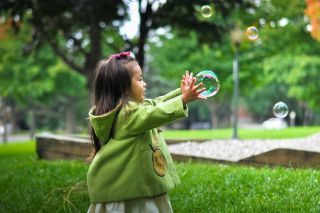Originally published in Psychology Today by Jenny Perkel, March 13, 2023
Parents are often looking for ways to help their ADHD children thrive. Most healthy children are busy, active, and constantly running around. But children with ADHD often need additional help to calm down, settle their minds, and focus their attention on the task at hand. There is an abundant supply of useful information online about how to manage ADHD. But don’t forget the benefits of different kinds of play – for all children, but especially for those with ADHD.
Why some children don’t play
In some communities around the world, playing seems to have gone a little out of fashion. Parents and educators sometimes set high standards of excellence and success for children, perhaps replacing the forgotten art of play with academics, competitions, and trophies. The value of simple, natural, social play — in the joyful spirit of childhood — is sometimes overlooked. Some children might be less playful because of their preference for digital devices and electronic games; they will often choose a screen over other games, activities, and toys. This is partly because of the addictiveness of certain digital games and also because machines are easier to control and less emotionally complicated than people. But children with ADHD might find it particularly hard to play with others.
ADHD goes hand in hand with behavioral complexities caused by impulsivity, difficulty regulating emotions, and an inability to delay gratification — or wait for something that is desperately desired. ADHD children often fall apart when they can’t get what they want, because of a reduced ability to tolerate frustration. Playing games with other children can be extremely frustrating. It involves waiting for others, taking turns, and sometimes losing. Children with ADHD can become highly impatient whilst playing, when others take too long, or when the game does not move quickly enough. They can lose interest easily, and might not be able to sit still or focus their attention for long enough to keep playing. Losing or not getting what they want can be extremely hard, causing children to lose their tempers, destroy the game, hurt other kids, and become uncontrollably upset. But despite these challenges, playing is just what children need, mostly to develop the frontal brain.
Why play?
The late Jaak Panksepp was a highly influential neuroscientist and psychobiologist. He was famous for his work on affective neuroscience — the study of emotions and the brain. He argued that ADHD symptoms could be alleviated if young children were given more opportunities to engage in play, especially with other children. His research suggests that abundant play during early childhood stimulates brain development, especially in the important frontal lobe. In 2007, Panksepp argued that intensive social play interventions throughout early childhood may alleviate ADHD symptoms. He discussed the use of play ‘sanctuaries,’ an idea first introduced by Plato. Panksepp proposed that a modern version of these play ‘sanctuaries’ be established for children at risk, in order to facilitate frontal lobe maturation and the healthy development of pro-social minds. The frontal-lobe regulatory skills to which Panksepp referred include an increased capacity for self-reflection, imagination, and empathy, leading to behavioral flexibility and well-focused goal-directed behaviors.
Free, unstructured play is beneficial for the developing mind but so is play that involves rules and the learning of skills. The benefits of play are often invisible but they are many and varied, including:
- social skills
- fine-motor skills
- gross-motor skills
- creativity
- delayed gratification
- frustration tolerance
- teamwork
- patience
- attention and concentration skills
- learning through failure
- balance and coordination
- cognitive functioning
- visual perceptual skills
- numerical reasoning
- spatial reasoning
- imagination
- visual tracking
- eye-hand coordination
- self-awareness
- personal and psychological growth
- short-term memory skills
How to get your child with ADHD to play
If your child is very young, one of the most therapeutic things you can do is to spend time playing with her or watching her play. If you can, whenever possible, encourage and present opportunities for your child to play with other children of a similar age. Most children, especially those with ADHD, need physical space to be energetic and active. Get your child outside so that she can run, climb, swing, and move around freely, preferably with other children. Daily chunks of time for free, unstructured play with other children of similar ages is important. In addition to this, structured play such as team sports, ball sports, after-school activities, art classes, creativity workshops, martial arts, learning a musical instrument, and participating in group activities can all be helpful and therapeutic. If any of these are extremely challenging for your child to the extent that she hates and dreads them, the destructiveness may outweigh the benefits. Find an activity best suited to her abilities and her current functioning. Be mindful and realistic about her limitations.
It’s not always easy to parent or teach children who have ADHD. But play can improve their behavior, enhance their ability to build friendships, and bring them joy.
